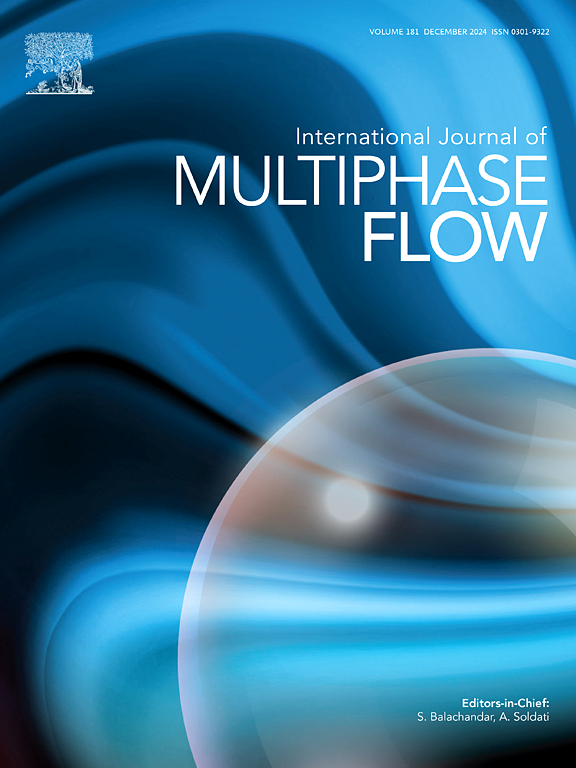有限粒径颗粒湍流沉降的逐点方法评价
IF 3.6
2区 工程技术
Q1 MECHANICS
International Journal of Multiphase Flow
Pub Date : 2025-05-17
DOI:10.1016/j.ijmultiphaseflow.2025.105276
引用次数: 0
摘要
我们研究了在统计稳定的均匀各向同性湍流中,直径为十个柯尔莫哥洛夫尺度、密度略大于载流密度的较大颗粒悬浮液的沉降。通过改变颗粒与流体的密度比,可以得到一个大范围的伽利略数,即浮力与粘性力的比值。我们使用高分辨率的单向耦合直接数值模拟来分析这个问题,其中粒子被建模为材料点。物理参数的选择范围与最近的粒子分辨模拟(PRS, Fornari et al., 2016;Fornari et al., 2016),我们对此进行比较。点方向模拟的结果与PRS的结果很好地一致,表明在所研究的参数范围内,悬浮液在水介质中沉降的速度降低,在密度比为1的数量级时,体积分数可达几个百分点。结果忽略了粒子间和粒子-流体相互作用,而在粒子运动方程中故意包括/排除了各种力(如Stokes阻力、附加质量、升力),以突出它们各自的贡献。在高伽利略数时,平均沉降速度仅受湍流波动的轻微影响,与静止流体中单个粒子的沉降速度相同。随着伽利略数的减小,沉降速度受到湍流波动的影响越来越大,湍流波动导致颗粒沉降速度显著降低。在一个参数范围内,静止流体中孤立粒子的沉降速度是湍流波动的均方根值的数量级。目前的结果与应用特别相关。通过与颗粒解析模拟的直接比较,可以证明具有精确水动力描述的点方向模型在捕获颗粒沉降速度和其他高阶统计量方面是有效的(Fornari等人,2016a;Fornari et al., 2016b)。本文章由计算机程序翻译,如有差异,请以英文原文为准。
Assessment of the point-wise approach for the Turbulent Settling of finite-size particles
We study the settling of suspensions of relatively large particles with diameters of the order of ten Kolmogorov scales and densities slightly greater than that of the carrier fluid in statistically steady homogeneous isotropic turbulence. The particle-to-fluid density ratio is varied to obtain a wide range of Galileo numbers, which are the ratios of buoyancy and viscous forces. We analyze the problem using high-resolution one-way coupled direct numerical simulations where the particles are modeled as material points. The physical parameters are chosen in the same range used in recent particle-resolved simulations (PRS, Fornari et al., 2016; Fornari et al., 2016), against which we compare. The results of the point-wise simulations are in good agreement with those of the PRS, showing a reduced settling speed for the range of parameters studied, relevant for suspensions settling in aqueous media, at volume fractions up to a few percent for density ratios of the order of one. The results are obtained neglecting the inter-particles and particle–fluid interactions, while the various forces (e.g. Stokes drag, added mass, lift force) are deliberately included/excluded in the equations of motion of the particles to highlight their respective contributions. At a high Galileo number, the mean settling velocity is only slightly affected by turbulent fluctuations, and it is the same as that obtained for the settling velocity of a single particle in a quiescent fluid. As the Galileo number is reduced, the settling velocity is increasingly affected by turbulent fluctuations that cause a significant decrease in the particle sedimentation speed. The transition occurs in a parameter range where the settling velocity of the isolated particle in a quiescent fluid is the order of the root mean square value of the turbulent fluctuations.
The present results are particularly relevant for applications. Point-wise models endowed with an accurate description of the hydrodynamic force are effective in capturing the particle settling speed and other higher-order statistics as demonstrated by direct comparison against particle-resolved simulations (Fornari et al., 2016a; Fornari et al., 2016b).
求助全文
通过发布文献求助,成功后即可免费获取论文全文。
去求助
来源期刊
CiteScore
7.30
自引率
10.50%
发文量
244
审稿时长
4 months
期刊介绍:
The International Journal of Multiphase Flow publishes analytical, numerical and experimental articles of lasting interest. The scope of the journal includes all aspects of mass, momentum and energy exchange phenomena among different phases such as occur in disperse flows, gas–liquid and liquid–liquid flows, flows in porous media, boiling, granular flows and others.
The journal publishes full papers, brief communications and conference announcements.

 求助内容:
求助内容: 应助结果提醒方式:
应助结果提醒方式:


